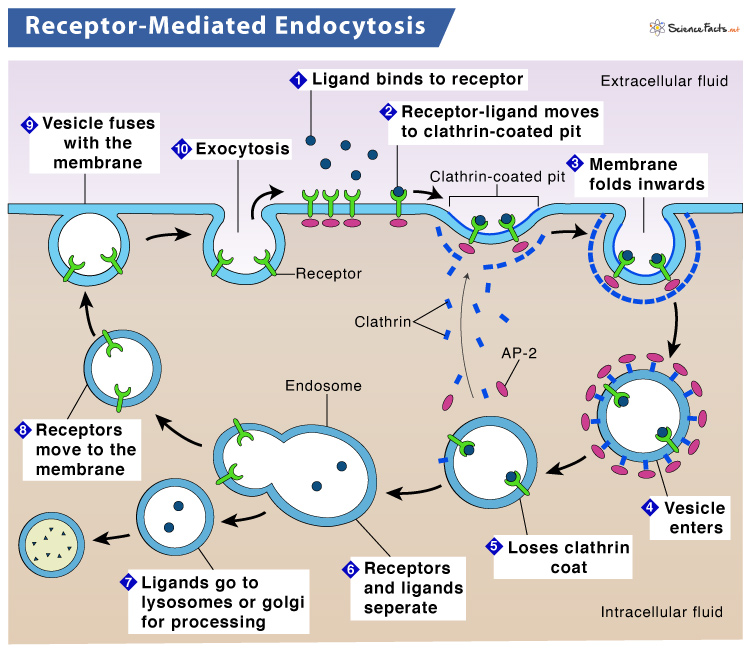These molecules adhere to receptors and enter the cell through the infolding of the plasma membrane, which eventually gets pinched off into a vesicle. Here an essential structural protein, clathrin, coats the budding vesicle giving it its distinctive spherical form. Since RME is a form of endocytosis that helps to ship molecules into the cell from the extracellular matrix through a clathrin-coated vesicle, it is alternatively called Clathrin-mediated endocytosis.
Where It is Found
Is It a Form of Active or Passive Transport
Functions and Examples
How does Receptor-Mediated Endocytosis Work RME is a type of targeted endocytosis. It involves transmembrane receptor proteins in the plasma membrane that possess a specific binding affinity for certain substances. These receptors occur in clusters in particular regions of the plasma membrane called coated pits. Clathrin, a protein located on the cytoplasmic side of a cell, coats the pit. Hence, they are known as clathrin-coated pits. Once the targeted molecule binds to the receptor, the internalization of the pit region begins, and clathrin-coated vesicles form. These vesicles get fused with early endosomes (membrane-bound sacs that help to sort incorporated material). Consequently, the clathrin coating gets removed. As a result, the contents get emptied into the cell. The uptake of specific compounds is dependent on the receptor involved in the process. If the process fails, the material will not get eliminated from the tissue fluids or blood. Instead, it will stay there and increase in concentration.
Steps
Uptake of LDL and Iron in Mammalian Cells
Cholesterol, being insoluble in body fluids, is transported into the mammalian cell through RME. It is transported in as low-density lipoprotein, the primary plasma carrier of cholesterol in the body. After incorporation, the LDLs get transported to lysosomes, degraded into amino acids, forming cholesterol and fatty acids. Finally, the cholesterol thus formed is directly incorporated into cell membranes or is reesterified and stored as lipid droplets in the cell for future use. RME also helps in the uptake of iron through the endocytosis of transferrin (an iron-binding protein) at the cell surface, with the help of the transferrin receptor (TfR). The process of uptake is similar to LDL.
Uptake of Large Biomolecules and Growth Factors
Several biomolecules are imported into the cell by RME. For example, glucose, the body’s primary energy source, is transported by the glucose transporter-1 receptor. An l-type amino acid transporter-1 receptor transports amino acids. Specific receptors also transport thiamin, biotin, folic acid, vitamin B12, and neuropeptides. Insulin-like growth factors, such as IGF-I, IGF-II, and leptin, are transported by the endogenous receptors located in the brain vascular endothelium.
Regulating Cell Signaling
RME of signaling receptors is a crucial mechanism to regulate signaling in cells. It can attenuate the strength or duration of many plasma membrane-regulated signaling processes by physically reducing the concentration of cell surface receptors accessible to the ligand. However, in some cases, it shifts the dose-response relationship. As a result, a higher concentration of a ligand is required to trigger a response of the same magnitude.
Facilitates Entry of Certain Viruses and Other Foreign Antigens
Several pathogens like bacteria and viruses generally enter the host cell for replication by exploiting the endocytosis machinery. However, unlike bacteria, viruses use the cell’s signaling mechanisms and regulatory pathways to induce endocytosis and prepare the host cell for invasion.
